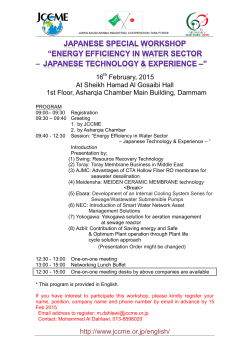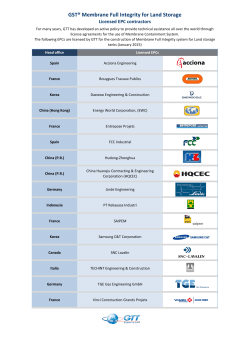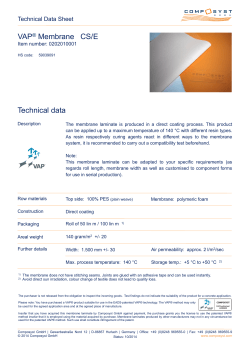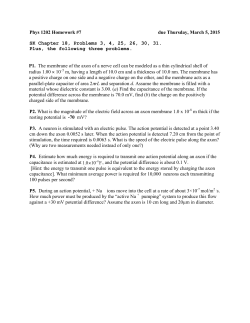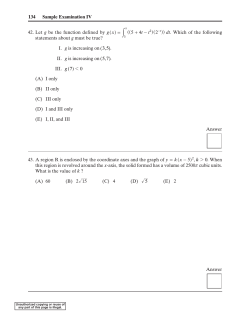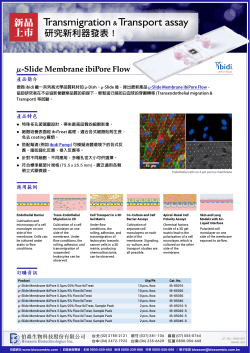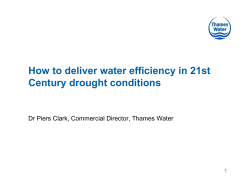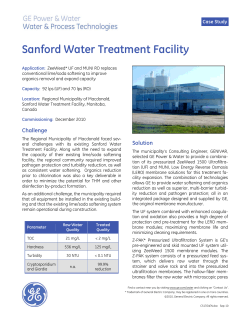
Integrated Bioparticle Concentration for Improved Detection in Autonomous Systems
Integrated Bioparticle Concentration for Improved Detection in Autonomous Systems Sample Prep 2011, San Diego, CA Andrew Page1, David Alburty1, Pam Murowchick2, Zachary Packingham1 1InnovaPrep, 2AlburtyLab, LLC Inc. 2 Outline I. InnovaPrep/Hydrosol Concentration Background II. Performance III. Integration with the Evogen Dryclone IV. Integration for DHS AESaP V. Integration with MFSI M-BAND InnovaPrep/Hydrosol Concentration Background 4 Automated Detection of Aerosolized Biological Weapons – Standard Practice Aerosol Collection Sample Prep Sample prep modules accept 50 – 500 µL Identification Identifiers accept 5 - 200 µL Waste/Archive 1.5 – 14.95 mL not analyzed Sample collection into 2 – 15 mL *75% to more than 99% of the sample is not analyzed! 5 Automated Detection of Aerosolized Biological Weapons – With Concentration Aerosol Collection CONCENTRATION Sample collection into 2 – 15 mL Interface between collected sample volume and accepted sample prep volume – “Macroto-Micro Interface” Sample Prep Sample prep modules generally accept 50 – 500 µL Identification Identifiers accept 5 - 200 µL *Delivery of nearly 100% of the collected signature is possible – providing orders of magnitude improvement in DL 6 Implementation of a Hydrosol Concentrator Advantages • Orders of magnitude improvement in detection limit • Increased freedom in selection of collector • Increased freedom in selection of detector Disadvantages • It adds another component to the system • It takes additional time • Co-concentration of Inhibitors is possible 7 The InnovaPrep Concentration Process • “Dead-end” filtration through a hollow fiber or flat membrane filter • Particles larger than the filter pore size are retained while the permeate fluid passes through • A viscous, expanded wet foam is pushed through the retentate tangential to the filter surface capturing the particles 8 The InnovaPrep Concentration Process 9 Wet Foam Elution • Mode of Operation • “Expanded Liquid” • Increased Viscosity – reduced channeling (Yan et al., 2006) • Moves as rigid body w/ narrow (<10 µm) lubricating layer (Briceno and Joseph, 2003; Tisne et al., 2004) • Bursting bubbles • Improved Elution • Lower minimum elution volumes • Higher elution efficiencies • Largely unaffected by sample matrix • Dramatic advantage for multi-fiber & flat membrane modules • Quickly Breaks Down into a Liquid 10 InnovaPrep Biological Concentrators HCI-40 (patents pending) HSC-40 (patents pending) Performance 12 Performance Metrics (for Autonomous Biothreat Detection Systems) • Speed • Generally less than 5 to 10 minutes is desired • Often less than 1 or 2 minutes is desired • Reusability • Reuse for hundreds of test runs is desired • Must withstand inhibitor materials (blinding) • Efficiency/Concentration Factor • >50% efficiency is desired • >5x concentration factor desired • Low instrument cost • Low per sample cost 13 Speed Speed is tied to: • Membrane pore size • Membrane surface area • Sample matrix/particle loading & makeup *For most biodefense applications bacteria, viruses, free DNA, proteins and toxins are concentrated into a single fraction. Approximates rates are: ~1 mL/min to concentrate into <200 uL ~3 mL/min to concentrate into <400 uL 14 Reusability Reusability is primarily tied to the parameters listed below • Membrane surface area • Sample matrix/particle loading and makeup *Reuse for up to 250 test runs has been demonstrated 15 Efficiency Concentration and Recovery of Carboxylate Polystyrene Microspheres Particle Size, µm 4.5 Represented Particle Agglomerates of bacteria Average Recovery 97% 1.0 Single bacteria 90% 0.05 Viruses 79% 0.025 DNA, Lower limitviruses 60% 16 Efficiency Concentration and Recovery of Microorganisms Species Concentration efficiency Bacillus thuringiensis israliensis (Bti) 97 % Bacillus atrophaeus (Bg) 95% Escherichia coli (Ec) 103% MS-2 bacteriophage 92% Bg DNA 60% 17 Cost • Instrument is a relatively simple, compact electromechanical instrument and thus cost is relatively low. • Sharing of common components can reduce cost further. • Per sample cost is very low due to reuse of concentration cells. Integration with the Evogen DryClone Integration for Concentration and Fluid Reuse 19 Integration with the Evogen DryClone • • • • • Cyclonic Collector w/ automated wet rinse Concentrate Volume Range Tested - 175 to 250 μL Demonstrated Concentration Factor - 3.1 to 20.1 Demonstrated Concentration Efficiency – 78% to 115% Fluid Reuse Demonstrated 20 Volume of Extraction Fluid Needed, mL Fluid Reuse 500 450 Experimental Data (Not Recycled) Experimental Data (Recycled) 400 Not Recycled Recycled 350 300 250 200 150 100 50 0 0 20 40 60 80 100 Number of 3 min Samples Collected 120 140 Integration for DHS AESaP US Department of Homeland Security Automated Environmental Sample Preparation Program (AESaP) 22 Passage & Concentration Recoveries • Flat membrane • Efficiency for passage of viruses, proteins, DNA InnovaPrep Recoveries • Efficiency for concentration of bacteria Recovery vs. input 120% 100% 80% 60% 40% 20% 0% FITC-BSA lambda DNA LentiProtein (<0.01) virus (<0.01) (0.01) ACNPV (0.05x0.3) 0.4 um cutoff Target (approx size in um) *Data provided by Darren Gray, FLIR E. coli (0.5x2) S. aureus B. (1) atrophaeus (1) 23 High Yield of Viable Vegetative Bacteria • Flat membrane • Yield by qPCR • Viability by plating Innovaprep Yield Viability (relative to input) Process yield of viable cells E. coli 94 ± 15% 77 ± 23% 71 ± 16% S. aureus 102 ± 3% 98 ± 3% 100 ± 6% *Data provided by Darren Gray, FLIR InnovaPrep input Cell Fraction output Integration with MFSI M-BAND Microfluidic Systems Inc.’s (MFSI) Microfluidic Bioagent Networked Detector (M-BAND) 25 Interferent Testing 26 Interferent Testing 27 Contact Information Dave Alburty Andy Page dalburty@innovaprep.com apage@innovaprep.com Phone: 816.619.3375 Phone: 816.868.6204 Zachary Packingham InnovaPrep LLC 132 E. Main St. Drexel, Missouri 64742 zpack@innovaprep.com Phone: 816.739.1905 www.innovaprep.com
© Copyright 2025
